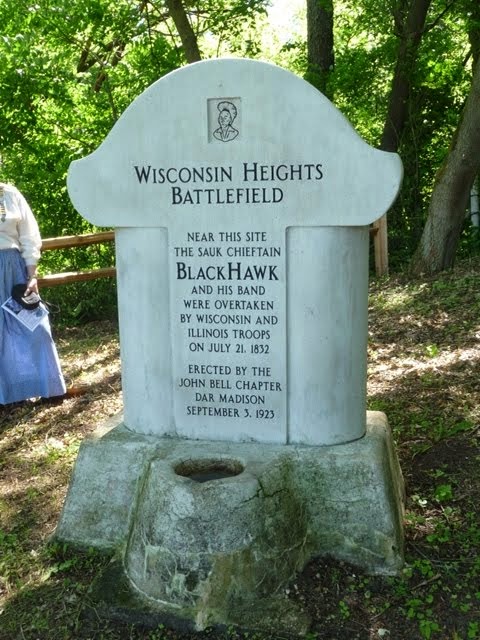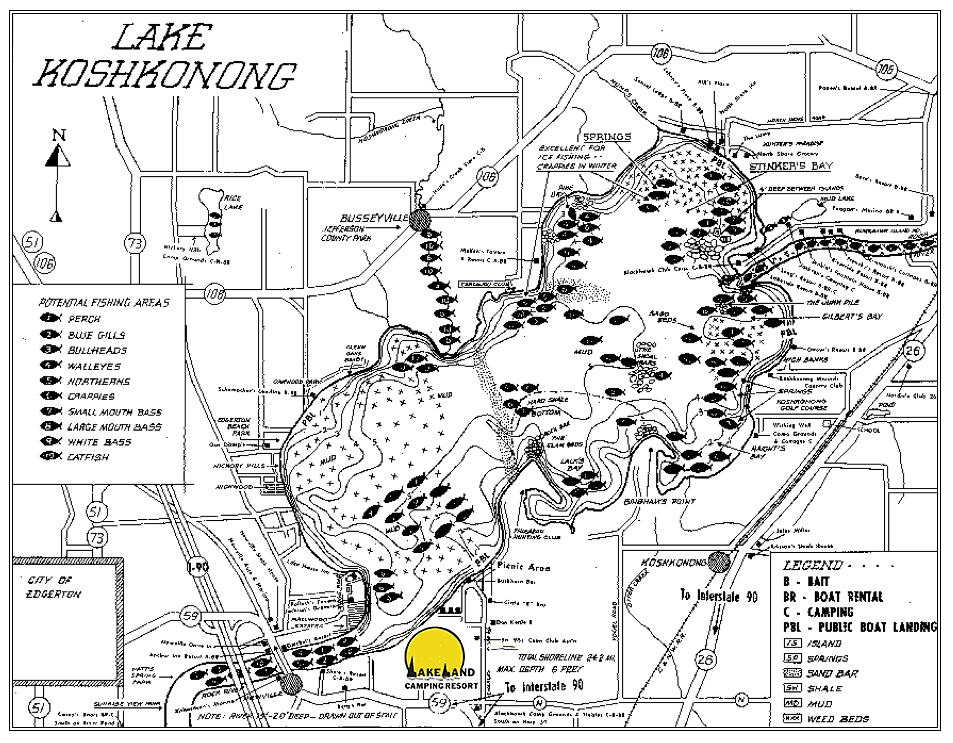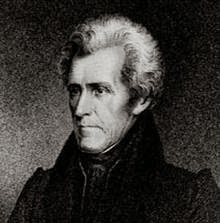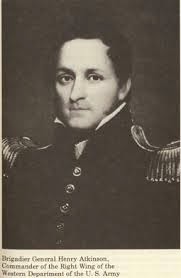 |
Sycamore Creek
Byron, IL |
In early May, 1832, Black Hawk was camped with his band about seven miles north of where Sycamore Creek runs into the Sinnissippi. Through conference with the local Potawatomi tribe, he learned of the presence of a military camp a few miles away, with a large number of men intent on war. Black Hawk recognized the danger to his people, and on May 14th, 1832, he sent a group of three emissaries to the camp with instructions to wave a white flag at the soldiers and surrender. In addition, a small group of scouts was dispatched to hide in the surrounding hills and observe the events of the surrender. The emissaries were instructed to tell the militia that Black Hawk no longer wished to make war with the Whites, and that he and his people wanted to return peacefully to Iowa. The three were taken prisoner immediately, for fear that the white flag was a trick. When the band of scout observers were discovered by watchmen, an enraged guard shot one of the three prisoners at point blank range, killing him instantly. The other two fled and survived. All the scouts fled, but were pursued by the militia and two were killed.
Those who survived made their way back to Black Hawk’s camp where a skirmish line was set up by Black Hawk and a small number
of warriors intent on engaging the militia, thus giving time for the rest of his band of people to escape. Black Hawk himself stated that he expected to die in the fight, outnumbered ten-to-one against nearly 300 advancing militia. Hiding in ambush, and fighting in the way that had kept him
 |
| Isaiah Stillman |
alive for so many years, Black Hawk and his small group of warriors fought so fiercely against the oncoming militia that Major Isaiah Stillman hastened a retreat, being among the first to run, and later reported that he had been under attack by “thousands of Indian warriors”. In the end, twelve militia soldiers were killed, and about as many Indians lost their lives.
Originally known as the Battle of Sycamore Creek, or the Battle of Old Man’s Creek, the conflict soon became known as the Battle of Stillman’s Run, a dubious honor for the man who had ordered the retreat. It was the first battle in what was eventually named, by white historians of the day, ‘The Black Hawk War’.
Black Hawk was now forced into a position where he could no longer peacefully retreat, and though he was not seeking a fight, one was following closely at his heels. The soldiers who fled the fight at Sycamore Creek regrouped at Dixon’s Ferry, bringing with them a wide-eyed tale of the massacre inflicted upon the militia by Black Hawk and his warriors. This ignited wide-spread terror, and the effort to confront The Warrior and end the threat was redoubled.
Lost in the many retellings of this story is the reason why it was necessary to drum up a second militia force. Many stories claim that the men were so disheartened by the debacle at Sycamore Creek that they left and went home. However, some volunteer soldiers who had been brought out to fight the “Bloodthirsty Band of Indians”, had opportunity to witness firsthand the nature of their foe. One soldier, after walking away from the militia, wrote in his diary he would rather spend his earthly life in restraint than to bear an eternity of damnation for killing the women, children, and elderly making up what was obviously a migration of peaceful Indians. Many such accounts exist, which have been carefully preserved and collected together for research. The men of the Illinois militia, having been deceived into thinking an Indian War was at hand, with unfettered application of fear, ignorance, treachery and foolishness proceeded forth, and a conflict was finally incited. Not by the Indians, but by the Illinois militia and American army who had been called upon to stop them. Even so, desertion from the militia was a continuous problem throughout the conflict as men learned the truth and walked away.
In one such reference, “The Sauks and the Black Hawk War” by Perry Armstrong, the scene between Saukenuk and Prophetstown was described in this way:
“Being entirely out of provisions, and half famished for food, his (Black Hawk’s) march, as a matter of necessity, was slow indeed. Fearful that the discharge of firearms by his braves would be the cause of attracting the attention and increasing the already widespread excitement among the pioneer white people, on account of his return across the Mississippi, he strictly forbid the firing of a gun under any circumstance; hence, they were compelled to depend upon the hook and line, spear, roots, bow and arrow for their means of subsistence on their march up the Rock River. Along their route were many deserted as well as tenanted log cabins of the white settlers, and although greatly in want of provisions, not a cow, steer, hog, or even a chicken was killed or molested by these Indians.”
 |
| Judge James Hall |
In another account called “History of The Indian Tribes of North America”, author Judge James Hall described the same events as follows:
“The Sauks, after resting a few days at their village (Saukenuk), pursued their march toward the country of the Pottawattamies, without concealment or violence. Notwithstanding their merciless rule of warfare, which spares no foe which may fall into their hands, however helpless, they passed by isolated cabins in the wilderness without offering the slightest outrage to the defenseless inhabitants. The property of the settlers residing on the lands of these very Indians remained untouched. Travelers between St Louis and Galena proceeding singly or in small parties through a wild region, now the reported seat of war, without molestation, while an army was on its march to the frontier, and the newspapers were filled with the reports of an Indian war with all its pomp and circumstance.”
Clearly, the band was peaceful, was not hiding, and was acting in deference to the white settlers by suffering hunger rather than use the weapons at their disposal. Many who had been called to fight them saw the farce of the action, and the extent of the deceit, and deserted the campaign. Until the events at Stillman’s Run, which Black Hawk viewed as the treacherous killing of warriors under a flag of truce, there was no conflict, and certainly no ‘War’. Now, with hostilities breached, there was no way to avoid it.
Unable to retreat to Iowa due to the military force in their path, Black Hawk and his band fled north toward the Michigan territory, in the hopes that Neopope’s promise of assistance from the Ho-Chunk and other tribes in the area of Milwaukee, as well as assistance from his long-time allies the British would come true. Their path led them briefly up Mill Creek, led by a Potawatomi guide, but eventually east again to the Sinnissippi. By May 19th, a reconstituted militia headed north along the Sinnissippi in pursuit.
(Key Terms: Ma-Ka-Tai-Me-She-Kia-Kiak, Black Sparrow Hawk, Black Hawk, 1767, Saukenuk, Pyesa, Rock Island, Black Hawk’s Watch Tower, Black Hawk State Historic Site, Hauberg Museum, Sauk, Sac, Meskwaki, Fox, Rock River, Sinnissippi River, Mississippi River, War of 1812, British Band, Great Britain, Treaty of 1804, Treaties, Ceded Land, William Henry Harrison, Quashquame, Keokuk, Fort Armstrong, Samuel Whiteside, Black Hawk War of 1832, Black Hawk Conflict, Scalp, Great Sauk Trail, Black Hawk Trail, Prophetstown, Wabokieshiek, White Cloud, The Winnebago Prophet, Ne-o-po-pe, Dixon’s Ferry, Isaiah Stillman, The Battle of Stillman’s Run, Old Man’s Creek, Sycamore Creek, Abraham Lincoln, Chief Shabbona, Felix St. Vrain, Lake Koshkonong, Fort Koshkonong, Fort Atkinson, Henry Atkinson, Andrew Jackson, Lewis Cass, Winfield Scott, Chief Black Wolf, Henry Dodge, James Henry, White Crow, Rock River Rapids, The Four Lakes, Battle of Wisconsin Heights, Benjamin Franklin Smith, Wisconsin River, Kickapoo River, Soldier’s Grove, Steamboat Warrior, Steamship Warrior, Fort Crawford, Battle of Bad Axe, Bad Axe Massacre, Joseph M. Street, Antoine LeClaire, Native American, Indian, Michigan Territory, Indiana Territory, Louisiana Territory, Osage, Souix, Potawatomi, Ojibwe, Ottawa, Ho-Chunk)


































